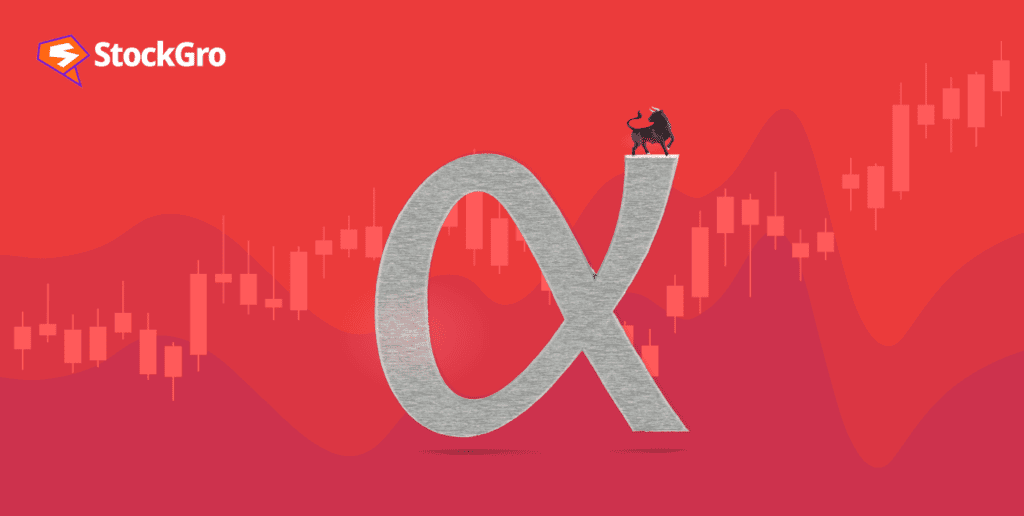
Alpha is a term that is loosely described as a measure of outperformance. Alpha is a highly discussed topic among fund managers as they are always seeking to outperform markets and generate alpha returns on their funds. If a portfolio manager can generate alpha in a bad year or a low-growth business cycle, you should know that you can trust him.
So let’s delve deep into what is alpha, its computations and the strategies one can adopt to generate it.
What is alpha in the stock market?
Alpha, also known as “alpha return” or simply “excess return”, is a financial metric that evaluates an investment’s performance compared to a benchmark index. It gauges the extent to which an investment has outperformed the market.
What is alpha and beta in finance and stocks
Alpha and beta are two metrics commonly found in finance and stock markets, which are used in assessing the performance as well as the risks of the investment concerning the total market.
Alpha:
Alpha in stock market gauges how well an investment has performed relative to a specific market index, such as the Nifty 50. Alpha is the amount of excess return or value over that of the overall market that the investment manager or investment strategy has managed to create.
When an investment has a positive alpha in stock market, it means that the investment has generated excess returns in relation to the risks taken. On the other hand, a negative alpha indicates underperformance.
For example, if a mutual fund has an alpha of +2, it means it has beaten the market by 2%. Alpha in stock market is a good indicator to assess the skill of fund managers or the effectiveness of investment strategies.
Beta:
Beta measures the volatility or risk of an investment compared to the overall market. A beta of 1 means the investment’s price will move in line with the market.
A beta higher than 1 indicates the investment is more volatile than the market, while a beta less than 1 suggests it is less volatile.
For example, a stock with a beta of 1.2 is expected to be 20% more volatile than the market, meaning if the market rises or falls by 10%, the stock could move by 12%. Investors use beta to understand how much risk they are taking by investing in a stock or fund.
So basically, alpha in stock market tells you how much value an investment adds, while beta shows how much risk it brings compared to the market. Together, they help investors make informed decisions.
You may also like: Understanding the P/E ratio
How do you interpret alpha returns in the stock market?
Alpha is an important metric for investors because it also helps to check the skills and performance of fund managers. Read on, to find out about the significant factors that affect alpha:
Skill vs luck
Alpha permits investors to distinguish between skill and luck when evaluating investment performance. A positive alpha in stock market means that the fund manager has outperformed the market, meaning that his skills actually helped him to outperform the market.
Performance evaluation
Alpha in stock market provides a more nuanced view of investment performance compared to simple returns. Investors can use it to evaluate whether a fund or portfolio manager’s strategies are effective in generating excess returns.
Benchmark comparison
Alpha enables investors to figure out how well an investment has performed compared to a benchmark like the Nifty 50 or Sensex. It offers insights into whether the portfolio strategy has beaten the market or fallen short of expectations.
Investment decision-making
Investors can use alpha in stock market to make informed investment decisions. Positive alpha may indicate that an investment is worth considering, while negative alpha may signal the need for a closer look at the investment strategy.
How to calculate alpha?
The formula for CAPM is:
E(Re) = Rf + (Rm-Rf)* β
E(Re)is the expected return on investment. Since alpha is the extra return that is earned over and above the expected return, alpha’s formula is:
Alpha = Actual Return – E(Re)
Let’s break down the components of the alpha return formula:
- Actual return: This is the actual return generated by the investment during a specific period.
- Risk-free rate (Rf): This is the minimum return you are likely to earn by investing in the safest government bond. This does not involve any risks.
- Beta (β): Beta is the stock’s sensitivity to the market. It quantifies how much the investment’s returns are expected to move about the benchmark index.
- Market return: This is the return earned from the benchmark index over the same period as the investment.
Let us understand this with an example:
Suppose an investment generates a return of 12% over a year, the risk-free rate is 2%, the market return is 10%, and the investment has a beta of 1.2.
Alpha = 12% – [2% + (1.2 * (10% – 2%))]
= 12% – [2% + (1.2 * 8%)] = 12% – [2% + 9.6%]
= 12% – 11.6%
Alpha return = 0.4%
In this example, the investment has a positive alpha of 0.4%, indicating that it outperformed the market by 0.4% after adjusting for its level of risk (as measured by beta).
Importance of alpha in stock market
Alpha in stock market is a measure of an investment’s performance compared to a market index or benchmark. It indicates how much value an investor adds to their portfolio beyond what the market provides. Here’s why it’s crucial:
- Performance Measurement: Alpha allows investors to assess how well a stock or fund manager is performing. A positive alpha in stock market indicates that the investment has outperformed the market, while a negative alpha suggests underperformance.
- Risk Assessment: Alpha helps investors evaluate the risk-adjusted returns. A high alpha can mean that a manager is adding value through skill, rather than just taking on more risk.
- Investment Strategy: By focusing on stocks with high alpha, investors can identify potential opportunities for better returns. It guides investors in selecting funds or stocks that may outperform their peers.
- Portfolio Management: Understanding alpha in stock market assists in making informed decisions about asset allocation, helping to enhance overall portfolio performance.
- Goal Setting: Investors often set performance goals based on alpha, aiming for a specific excess return over the benchmark.
So remember, Alpha is not just a number; it is an essential instrument for making worthwhile investments in the stock market. Thus, whether you are an experienced investor or a beginner in making stock investments, you should always remember to assess alpha.
Also read: Beat the market: Your ultimate guide for fundamental analysis tools.
How can a fund manager generate alpha in trading?
Now that we understand what alpha is and how it is calculated, let us explore a few basic strategies for attaining alpha in stock market:
Active portfolio management
Skilled fund managers and investors actively select stocks or other assets they believe will outperform the market. It involves in-depth research of the assets where the fund manager wishes to put his money.
Factor-based investing
Portfolio managers use models like the Fama & French model where factor-based investing is done. It involves targeting factors like value, growth, quality or momentum to drive excess returns.
Market timing
Timing the market by identifying favourable entry and exit points can lead to alpha generation. However, market timing is difficult and risky, as it requires accuracy in predicting the market movements.
Arbitrage strategies
These opportunities arise when there are differences in the price of the same assets in other markets. Portfolio managers quickly identify these opportunities and execute the buy-sell orders simultaneously to benefit from these price differences.
Alternative investments
Alternative assets like private equity, hedge funds or real estate offer avenues for alpha. These assets allow investors to diversify their portfolios and capture alpha.
Also read: The market value effect – how can it make or break your investments?
Conclusion
Alpha is a fundamental concept in stock market investing. Understanding alpha in the market is essential for checking the skills of a portfolio manager. While alpha offers the potential for outperformance, it comes with challenges. Investors should carefully consider their investment goals, risk tolerance, and time horizon when seeking alpha. It is ideal to combine alpha-seeking strategies with passive index investing for a well-rounded portfolio.

